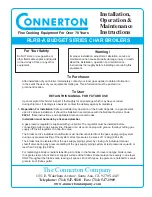
7
1-4
INS
TALLER
US
ER
MAINTEN
AN
CE TECHNI
CI
AN
extremely dangerous situations for the user.
The flue ducts must be connected to the chimney
or flue in the same room in which the appliance
is installed or, at most, in the adjoining room and
must comply with the requirements indicated
by the current technical regulations (Fig. 1-4).
1.8 FLUES/CHIMNEYS.
For the appliances with natural draught indi-
vidual chimneys and branched flues can be used.
Individual chimneys.
The individual flues must
be dimensioned with respect to the standard
in force.
Branched flues.
In buildings with lots of floors,
branched flues can be used for the natural
draught evacuation of combustion products. New
flues must be designed following the calculation
method and provisions of the regulation.
Chimney caps.
The chimney cap is a device
positioned on the top of an individual chimney
or branched collective flue. This device promotes
the dispersion of combustion products, even in
adverse weather conditions, and prevents the
deposit of foreign bodies.
It must satisfy the requisites set forth in the rela-
tive regulation.
The outlet quota, corresponding to the top of the
chimney/flue, independently of any caps, must
be out of the “respect area”, in order to prevent
the formation of counter-pressures that impede
the free discharge of the combustion products
into the atmosphere. It is therefore necessary to
use the minimum heights indicated in the figures
stated in current technical regulations.
Direct exhaust outside.
The natural draught
appliances, envisioned to be connected to a
chimney or a flue, can discharge the combus-
tion products directly to the outside, through
a pipe passing through the perimeter walls of
the building. In this case discharge takes place
through an flue duct, which is connected to a
draught terminal at the outside.
Positioning the draught terminals.
The draught
terminals must:
- be installed on external perimeter walls of the
building;
- be positioned according to the minimum dis-
tances specified in current technical standards.
Combustion products exhaust of natural
draught or fan assisted appliances in open-top
closed environments.
In spaces closed on all
sides with open tops (ventilation pits, courtyards
etc.), direct flue gas exhaust is allowed for natural
or forced draught gas appliances with a heating
power range from 4 to 35 kW, provided the
conditions as per the current technical standards
are respected.
Important:
it is prohibited to put the fumes
exhaust control device out of order voluntarily.
Every piece of this device must be replaced using
original spare parts if they have deteriorated. In
the case of repeated interventions of the fumes
exhaust control device, check the fumes exhaust
flue and the ventilation of the room in which the
water heater is located.
1.9 GAS SYSTEM START-UP.
To start up the system, refer to the technical
standard in force: This divides the systems and
therefore the start-up operations into three
categories: new systems, modified systems, re-
activated systems.
In particular, for new gas systems:
- open windows and doors;
- avoid presence of sparks or open flames;
- bleed all air from the pipelines;
- check that the internal system is properly sealed
according to the specifications set forth by
technical regulations in force;
1.10 APPLIANCE START-UP (IGNITION).
In order to issue the Declaration of Conform-
ity required by the laws in force, the following
requirements must be fulfilled to commission
the water heater (the operations listed below
must only be performed by a qualified firm and
without any unauthorised persons):
- check that the internal system is properly sealed
according to the specifications set forth by
technical regulations in force;
- ensure that the type of gas used corresponds to
water heater settings;
- Check that there are external factors that may
cause the formation of fuel pockets;
- switch the appliance on and check correct
ignition;
- make sure that the gas flow rate and relevant
pressure values comply with those given in the
manual (see par. 3.8);
- check the correct ventilation of the rooms;
- check the existing draught during normal
functioning of the appliance, e.g. a draught
gauge positioned at the exit of the appliance
combustion products;
- check that there is no backflow of combustion
products into the room, even during function-
ing of fans;
- ensure that the chimney safety device inter-
venes in the event of gas supply failure and
check the relative intervention time;
The water heater must not be started up even if
only one of the checks should be negative.
1.11 KITS AVAILABLE ON REQUEST.
• Polyphosphate dispenser kit (on request). The
polyphosphate dispenser reduces the forma-
tion of lime-scale and preserves the original
heat exchange and domestic hot water produc-
tion conditions. The water heater is prepared
for application of the polyphosphate dispenser
kit.
• Gas interception cock kit (on request). The
water heater is set-up for installation of the
gas interception cock to be inserted on the fuel
supply pipe. The gas cock is indispensable and
must be type-approved for the pre-fixed use.
• Gas pressure stabiliser kit. The water heater
is set-up for installation of the gas pressure
stabiliser kit to be inserted on the fuel sup-
ply pipe, which allows to have the supply at a
constant pressure, maintaining the water heater
performance unaltered.
The above-mentioned kits are supplied complete
with instructions for assembly and use.
minimum slope 5%
2500 mm max.






































